Lagerstätte
The examples and perspective in this article deal primarily with the English-speaking world and do not represent a worldwide view of the subject. (December 2022) |
| Part of a series on |
| Paleontology |
|---|
 |
|
Paleontology Portal Category |

A lagerstätte (German:
Worldwide, some of the best examples of near-perfect fossilization are the
Types
- Konzentrat-lagerstätten (concentration lagerstätten) are deposits with a particular "concentration" of disarticulated organic hard parts, such as a bone bed. These lagerstätten are less spectacular than the more famous konservat-lagerstätten. Their contents invariably display a large degree of time averaging, as the accumulation of bones in the absence of other sediment takes some time. Deposits with a high concentration of fossils that represent an in situ community, such as reefs or oyster beds, are not considered lagerstätten.
- Konservat-lagerstätten (conservation lagerstätten) are deposits known for the exceptional preservation of fossilized organisms or traces. The individual Solnhofen limestone with the earliest known bird, Archaeopteryx.


Preservation
Konservat-lagerstätten preserve lightly
A number of
- Orsten-type and Doushantuo-type preservations preserve organisms in phosphate.
- silica.
- Carbonaceous films are the result of Burgess Shale-type preservation
- Pyrite preserves exquisite detail in Beecher's trilobite-type preservation.
- Ediacaran-type preservation preserves casts and moulds with the aid of microbial mats.
Notable lagerstätten
The world's major lagerstätten include:
Precambrian
| Site(s) | Age | Location | Significance | Notable fossils/organisms |
|---|---|---|---|---|
| Nonesuch Formation | 1083-1070 Ma | Michigan, USA | A Mesoproterozoic lake containing exceptionally preserved limnic microbes.[4] | |
|
Lakhanda Lagerstätte |
1030-1000 Ma |
Uchur-Maya Depression, Russia |
A site preserving evidence of trophic interactions from the Boring Billion.[5][6] | |
|
Bitter Springs
|
1000–850 Ma
|
South Australia |
Preserved fossils include microfossils .
|
 |
| Dolores Creek Formation | 950 Ma | Yukon, Canada | An Early Tonian site containing pyritised macroalgal fossils.[7] | |
|
Chichkan Lagerstätte |
775 Ma |
Kazakhstan |
A site from the transition between the prokaryote-dominated biota of the Early Neoproterozoic and the eukaryote-dominated biota of the Late Neoproterozoic and Phanerozoic.[8] | |
|
600–555 Ma |
Guizhou Province, China |
Spans the poorly understood interval between the end of the period and the late Ediacaran Avalon explosion .
|
 | |
| Portfjeld Formation | 570 Ma | North Greenland | A Middle Ediacaran biota from the continent of Laurentia exhibiting Doushantuo-type preservation.[9] | |
|
Mistaken Point
|
565 Ma |
Newfoundland, Canada |
This site contains one of the most diverse and well-preserved collections of fossils .
|
 |
|
555 Ma |
South Australia |
The type location the Ediacaran period, and has preserved a significant amount of fossils from that time. |
 | |
| Shibantan Lagerstätte | 551-543 Ma | Hubei, China | A terminal Ediacaran fossil assemblage preserving life forms living just before the Proterozoic-Phanerozoic transition.[10] | |
| Gaojiashan Lagerstätte | 551-541 Ma | Shaanxi, China | A lagerstätte documenting tube growth patterns of Cloudina.[11] | |
|
Khatyspyt Lagerstätte |
544 Ma |
Yakutia, Russia |
A Late Ediacaran lagerstätte preserving an Avalon-type biota.[12] |
Cambrian
| Site(s) | Age | Location | Significance | Notable fossils/organisms |
|---|---|---|---|---|
|
Maotianshan Shales (Chengjiang) |
518 Ma |
Yunnan, China |
The preservation of an extremely diverse faunal assemblage renders the Maotianshan shale the world's most important for understanding the evolution of early multi-cellular life. |
 |
|
518 Ma |
Hubei, China |
This site is particularly notable due to both the large proportion of new taxa represented (approximately 53% of the specimens), and the notable volume of soft-body tissue preservation. |
 | |
|
523-518 Ma |
A site known for its fauna, and that they were most likely preserved by a death mask. It is a part of the larger Buen Formation, and has a fauna similar to the Maotianshan shales. |
 | ||
| Poleta Formation | 519-518 Ma | Nevada, USA | The middle member of the formation preserves the Indian Springs Lagerstätte, one of the oldest such sites from former Laurentia. This site preserves a diversity of mineralized organisms such as trilobites and brachiopods, but also non-mineralized remains such as sponges, algae, and soft-bodied arthropods.[13] |  |
|
Sinsk Algal Lens |
518 Ma |
One of the oldest known Cambrian lagerstätten. The fauna of this site is unique, as it seems that they were adapted to living in dysaerobic conditions.[14] |
 | |
|
513 Ma |
Noted soft tissue mineralization, most often of blocky apatite or fibrous calcium carbonate, including the oldest phosphatized muscle tissue. |
 | ||
|
513–501 Ma |
Guizhou, China |
The middle part of the Kaili Formation, the Oryctocephalus indicus Zone, contains a Burgess Shale-type lagerstätte with many well-preserved fossils known collectively as the Kaili Biota. |
 | |
|
Murero Lagerstätte |
511-503 Ma |
Spain |
Thanks to the paleontological content, mainly trilobites, fourteen biozones have been established, the most precise biozonation for this time interval in the world. It also records in detail the so-called Valdemiedes event, the mass extinction episode at the end of the Lower Cambrian.[15] |
 |
|
~510–500 Ma |
Central Wisconsin, US |
This site preserves some of the oldest evidence of multicellular life walking out of the ocean, and onto dry land (in the form of large mollusks and euthycarcinoid arthropods). Other notable fossils include stranded scyphozoans, and some of the oldest true crustaceans (in the form of phyllocarids). |
 | |
|
508 Ma |
British Columbia, Canada |
One of the most famous fossil localities in the world. It is famous for the exceptional preservation of the soft parts of its fossils. At 508 million years old (middle Cambrian), it is one of the earliest fossil beds containing soft-part imprints. |
 | |
|
507 Ma |
A site known for its abundant Cambrian trilobites and the preservation of Burgess Shale-type fossils. The type locality for this site is Spence Gulch in southeastern Idaho. |
 | ||
|
Linyi Lagerstätte |
504 Ma |
Shandong, China
|
A lagerstätte recognised for its exceptional preservation of arthropod limbs, intestines, and eyes.[16] |
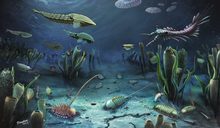 |
|
504 Ma |
Western Utah, US |
A world-famous locality known for its prolific Elrathia kingii trilobite remains. Varied soft bodied organisms are also locally preserved, including Naraoia, Wiwaxia and Hallucigenia .
|
 | |
|
502 Ma |
Western Utah, US |
A site known for its occasional preservation of soft-bodied tissue, and diverse assemblage. |
 | |
|
500 Ma |
Western Utah, US |
A site that is dominated by trilobites and brachiopods, but also comprising various soft-bodied organisms, such as Falcatamacaris .
|
 | |
|
Kinnekulle Orsten and Alum Shale |
500 Ma |
The Orsten sites reveals the oldest well-documented pentastomids are known. Multiple "Orsten-type" lagerstätten are also known from other countries.
|
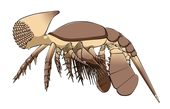 |
Ordovician
| Site(s) | Age | Location | Significance | Notable fossils/organisms |
|---|---|---|---|---|
|
about 485 Ma |
Draa Valley, Morocco |
It was deposited in a marine environment, and is known for its exceptionally preserved fossils, filling an important preservational window beyond the earlier and more common Cambrian Burgess shale-type deposits .
|
hurdiid radiodont | |
|
About 470 Ma (early-middle Floian) |
Hunan Province , China
|
Preserves Early Ordovician fauna with soft tissue, includes not only Cambrian relics but also taxa originated during Ordovician.[17] | ||
|
About 461 Ma |
Llandrindod Wells, Wales |
A unique environment deposited during the middle Ordovician that possibly shows iconic groups from Cambrian lagerstättes, like Opabiniids and Megacheirans, survived for longer than what was thought. |
 | |
|
Douglas Dam Member[18]
|
460 Ma |
Tennessee, US |
Low-diversity assemblage of arthropod fossils, which are preserved well because of volcanic ash. |
 |
|
460 Ma |
Decorah, Iowa
|
A Middle Ordovician site confined to a large impact Crater that is known for exceptionally exquisite preservation of conodonts, bivalved arthropods, and the earliest eurypterids in the fossil record.[19] |
 | |
|
460? Ma |
New York, US |
Noted exceptionally preserved trilobites with soft tissue preserved by pyrite replacement. |
Triarthrus trilobites with pyritized soft-tissue | |
|
? (Sandbian) |
Colorado, US |
Although preservation is not excellent, this lagoonal site provides early vertebrate fossils such as Astraspis and Eriptychius. |
 | |
|
Walcott-Rust Quarry
|
about 455? Ma |
New York, US |
This site is an excellent example of an obrution (rapid burial or "smothered") Lagerstätte. |
Isotelus gigas, a large asaphid trilobite |
Big hill Lagerstätte
|
about 450? Mya | Michigan, US | A site known for its preservation of soft-bodied medusae (jellyfish), as well as linguloid brachiopods, algae, and arthropods (namely chasmataspidids, leperditid ostracods, and eurypterids). |  |
|
Brechin Lagerstätte |
450 Ma |
Ontario, Canada |
Known for preserving one of the most diverse crinoid fauna of the Katian.[20] |
marrellomorph |
|
450? Ma |
South Africa |
Known for its remarkable preservation of soft-tissue in fossil material. Deposited in still waters, the unit lacks bioturbation, perhaps indicating anoxic conditions. |
 | |
|
Tafilalt, Morocco |
Known from range of non-biomineralised and soft-bodied organisms in polar environment.[21] |
 | ||
|
Cat Head Member[18]
|
? (middle Katian) |
Manitoba, Canada |
Fossils like algae, conulariids and trilobites are known from this site.
|
|
|
449-445.6 Ma |
Manitoulin , Canada
|
Low-diversity assemblage of arthropod fossils. |
waeringopterid eurypterid | |
|
William Lake (Stony Mountain Formation)[18] |
445 Ma |
Manitoba, Canada |
Well-preserved fossils like xiphosurans, sea spiders are known from this site, it is important since many of the fossils are unknown in other Ordovician sites.
|
 |
|
Airport Cove[18] |
445 Ma |
Manitoba, Canada |
Fossils like eurypterids, algae and xiphosurans are preserved in this site. |
Silurian
| Site(s) | Age | Location | Significance | Notable fossils/organisms |
|---|---|---|---|---|
|
Kalana Lagerstätte |
~440 Ma |
Estonia |
Known for well preserved fossils of algae and crinoids.[22] |
osteostracan |
|
Chongqing Lagerstätte (Huixingshao Formation)[23] |
436 Ma |
Chongqing, China |
This site preserved complete fossils of earliest galeaspids and eurypterids .
|
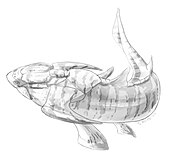 |
|
~435 Ma Early Silurian
|
Wisconsin, US |
Well-studied site known for the exceptional preservation of its diverse, soft-bodied and lightly skeletonized fauna, includes many major taxa found nowhere else in strata of similar age. It was one of the first fossil sites with soft bodied preservation known to science.
|
 | |
|
Herefordshire Lagerstätte (Coalbrookdale Formation) |
~430 Ma |
UK
|
Known for the well-preserved fossils of various invertebrate animals many of which are in their three-dimensional structures. Fossils are preserved within volcanic ash, because of that sometimes this site has been compared to Pompeii.[24] Some of the fossils are regarded as earliest evidences and evolutionary origin of some of the major groups of modern animals. |
 |
|
Eramosa Lagerstätte
|
~425 Ma |
Known for preservation of both hard and soft bodied organisms in great detail, including early scorpions, eurypterids, agnathan vertebrates, and several other species. |
 | |
|
Bertie Group
|
422.9-416 Ma |
Ontario & New York State |
This limestone have produced thousands of fossil eurypterids, such as giant Acutiramus and well-known Eurypterus, as well as other fauna like scorpions and fish. |
acanthodian |
|
~420 Ma |
Pennsylvania, US |
Known from exceptionally preserved mass assemblage of Eurypterus, the most abundant eurypterid in the fossil record. |  | |
|
Rochester Shale
|
415 Ma[26] |
New York, US and Ontario, Canada |
Echinoderms (such as crinoids) and trilobites are known from Lewiston Member in this shale. |  |
Devonian
| Site(s) | Age | Location | Significance | Notable fossils/organisms |
|---|---|---|---|---|
| Rhynie chert | 400 Ma | Scotland, UK | The Rhynie chert contains exceptionally preserved plant, fungus, lichen and animal material (euthycarcinoids, branchiopods, arachnids, hexapods, etc) preserved in place by an overlying volcanic deposit and hot springs. As well as one of the first known fully terrestrial ecosystems. | lycopods |
| Waxweiler Lagerstätte (Klerf Formation) | 409-392 Ma | Eifel, Germany | Waxweiler Lagerstätte is known from well-preserved fossils of Jaekelopterus rhenaniae shows the largest arthropod ever known.
|
 |
| Heckelmann Mill | 395 Ma | Rhineland-Palatinate, Germany | Heckelmann Mill preserves well preserved rhinocaridid archaeostracan phyllocarids,[27] along with exceptionally abundant crinoid holdfasts from the late Emsian.[28] | |
Hunsrück Slates (Bundenbach) |
390 Ma | Rheinland-Pfalz, Germany | The Hunsrück slates are one of the few marine Devonian lagerstätte having soft tissue preservation, and in many cases fossils are coated by a pyritic surface layer. |  |
| Gogo Formation | 380 Ma (Frasnian) | Western Australia | The fossils of the Gogo Formation display three-dimensional soft-tissue preservation of tissues as fragile as nerves and embryos with umbilical cords. Over fifty species of fish have been described from the formation, and arthropods. | placoderm fish that is the oldest vertebrate known to give live birth |
| Miguasha National Park (Escuminac Formation) | 370 Ma | Québec, Canada | Some of the fish, fauna, and spore fossils found at Miguasha are rare and ancient species. For example, tetrapods .
|
antiarch placoderm Bothriolepis |
| Kowala Lagerstätte | ~368 Ma | Świętokrzyskie Voivodeship, Poland | A Late Devonian site known for its fossils of non-biomineralised algae and arthropods.[29] | |
| Maïder Basin | 368 Ma (for Thylacocephalan Layer) | Anti-Atlas, Morocco | Thylacocephalan Layer and Hangenberg Black Shale in this basin provides well-preserved fossils of placoderms that preserved soft tissues.[30]
|
 |
| Strud[31] | ? (Late Famennian) | Namur Province, Belgium | Mainly juvenile placoderms are known, suggesting this site would be nursery site of placoderms.[32] Various biota like tetrapods, arthropods and plants are also known, Strudiella from this site may be the earliest insect, but its affinity is disputed. | notostracan . |
Canowindra, New South Wales (Mandagery Sandstone ) |
360 Ma | Australia | An accidentally discovered lagerstätte known for its exceptional preservation of Placoderm fish.
|
 |
| Waterloo Farm Lagerstätte (Witpoort Formation) | 360 Ma | South Africa | Important site that providing the only record of a high latitude (near polar) coastal ecosystem, overturning numerous assumptions about high latitude conditions during the latest Devonian. |  |
Carboniferous
| Site(s) | Age | Location | Significance | Notable fossils/organisms |
|---|---|---|---|---|
| Granton Shrimp Bed | ? (Dinantian) | Firth of Forth, Scotland | Dominated by well-preserved crustacean fossils, this site provided first body fossil of Clydagnathus which solved long-lasted mystery of conodont fossils. | |
| East Kirkton Quarry[33] | 335 Ma | West Lothian, Scotland | This site has produced numerous well-preserved fossils of early tetrapods like temnospondyls or reptiliomorphs , and large arthropods like scorpions or eurypterids.
|
reptiliomorph |
| Bear Gulch Limestone | 324 Ma | Montana, US | A ray finned fish, arthropods, and the possible mollusk Typhloesus are also known from the site.
|
holocephalian which males had large fin spine |
| Bickershaw[34] | ? ( Langsettian ) |
Lancashire, England | This locality contains exceptionally preserved fossils within nodules. Arthropods have greater diversity, many of which are aquatic ones that lived in brackish environment. | Valloisella , a xiphosuran |
Joggins Fossil Cliffs (Joggins Formation ) |
315 Ma | Nova Scotia, Canada | A fossil site that preserves a diverse terrestrial ecosystem consisting of plants like lycopsids, giant arthropods, fish, and the oldest known sauropsid, Hylonomus. |  |
| 310 Ma | Ohio, US | A site known for its number of prehistoric tetrapods, like the lepospondyl Diceratosaurus.[37] |  | |
Mazon Creek |
310 Ma | Illinois, US | A conservation lagerstätte found near Morris, in Grundy County, Illinois. The fossils from this site are preserved in ironstone concretions with exceptional detail. The fossils were preserved in a large delta system that covered much of the area. The state fossil of Illinois, the enigmatic animal Tullimonstrum, is only known from these deposits. |  |
| Kinney Brick Quarry (Atrasado Formation) | around 307 Ma | New Mexico, US | This site is known from rich fish fossils with preserved soft tissues, that lived in lagoonal environment. Dozens of fish genera are known, ranging from chondrichthyeans like ctenacanths and actinopterygians and sarcopterygians.[38]
|
ctenacanth |
| Montceau-les-Mines | 300 Ma | France | Exceptional preservation of Late Carboniferous fossil biota are known, including various vertebrates and arthropods, as well as plants.[39][40] |  |
| Hamilton Quarry | 300 Ma | Kansas, US | This site is known for its diverse assemblage of unusually well-preserved marine, euryhaline, freshwater, flying, and terrestrial fossils (invertebrates, vertebrates, and plants). This extraordinary mix of fossils suggests it was once an estuary. |  |
| Carrizo Arroyo | ? (Latest Gzhelian to earliest Asselian) | New Mexico, US | This site is known from exceptional preservation of arthropod fossils, mainly insects.[41] |
Permian
| Site(s) | Age | Location | Significance | Notable fossils/organisms |
|---|---|---|---|---|
| Franchesse | 292 Ma | Massif Central, France | A Sakmarian seymouriamorph lagerstätte from the Bourbon l'Archambault Basin in the French Massif Central containing hundreds of complete seymouriamorph specimens.[42] | |
| Chemnitz petrified forest | 291 Ma | Saxony, Germany | A horsetails that are ancestors of modern horsetails, found on this location with never seen multiple branches. Many more plants and animals from this excavation are still in an ongoing research.[43]
|
 |
| Mangrullo Formation | about 285–275 Ma (Artinskian) | Uruguay | This site is known for its abundant mesosaur fossils. It also contains the oldest known konservat-lagerstätte in South America, as well as the oldest known fossils of amniote embryos.[44] | 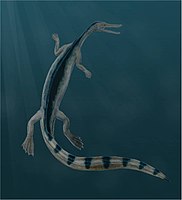 |
| Chekarda (Koshelevka Formation) | about 283–273 Ma | Perm, Russia | Over 260 species of insect species are described from this site as well as diverse taxa of plants, making it one of the most important Permian konservat-lagerstätten.[45] | |
| Toploje Member | 273-264 Ma | Prince Charles Mountains, Antarctica | This site preserves a high-latitude fauna in exceptional position before the large extinctions that happened later in the Permian.[46] | |
| Onder Karoo | 266.9–264.28 Ma | Karoo Basin, South Africa | A high latitude, cool-temperate lacustrine ecosystem preserving detailed plant and insect fossils.[47] | |
| Sakamena Group[48] | 260–247 Ma | Madagascar | neodiapsids .
|
 |
| Kupferschiefer | 259–255 Ma | Central Europe | This site deposited in an open marine and shallow marine environment provides fossils of reptiles as well as many fish. | weigeltisaurid reptile |
| Huopu Lagerstätte | ~255 Ma | Guizhou, China | A plant fossil site documenting floral dynamics between the end-Permian extinction events.[49]
|
Triassic
| Site(s) | Age | Location | Significance | Notable fossils/organisms |
|---|---|---|---|---|
| Guiyang biota[50] | 250.8 Ma | Guizhou Province , China
|
The oldest known , including several species of fish. | ray-finned fish |
| Paris biota[51] | ~249 Ma | Idaho, Nevada, USA | This earliest coleoids ).
|
 |
| Jialingjiang Formation[52] | 249.2–247.2 Ma | Hubei Province , China
|
This site preserved aquatic reptiles soon after Permian extinction. filter feeding .
|
 |
| Nanlinghu Formation[52] | 248 Ma | Anhui Province , China
|
This site provides important fossils to show early evolution of ichthyosauriforms .
|
 |
Petropavlovka Formation |
248 Ma | Orenburg Oblast, Russia | A site known for preserving oligochaetes, whose fossil record is extremely sparse.[53] | |
| Luoping Biota (Guanling Formation)[54] | ~247-245 Ma | Yunnan, China | Various marine animals are preserved in this site, showing how marine ecosystem recovered after Permian extinction. |  |
| Grès à Voltzia | 245 Ma | France | A fossil site remarkable for its detailed myriapod specimens.[55] | |
| Besano Formation[52] | 242 Ma | Alps, Italy and Switzerland | This formation is designated as a World Heritage Site, as it is famous for its preservation of Middle Triassic marine life including fish and aquatic reptiles. | archosauromorph |
| Xingyi biota (Zhuganpo Formation)[52] | ? (Upper Ladinian - Lower Carnian) | Guizhou and Yunnan, China | Previously considered as part of Falang Formation, this site yields many articulated skeletons of marine reptiles, as well as fish and invertebrates. | sauropterygian from this site |
| Guanling biota (Xiaowa Formation)[52] | ? (Carnian) | Guizhou, China | Like Xingi Biota, this site also yields well-preserved marine fauna, especially many species of thalattosaurs are known.
|
pantestudine (relative of turtles ) |
| Polzberg | 233 Ma | Austria | A site known for exceptional preservation of bromalites Carnian Pluvial Event.[58]
| |
| Madygen Formation | 230 Ma | Kyrgyzstan | The Madygen Formation is renowned for the preservation of more than 20,000 fossil insects, making it one of the richest Triassic lagerstätten in the world. Other vertebrate fossils as fish, synapsids have been recovered from the formation too, as well as minor fossil flora.
|
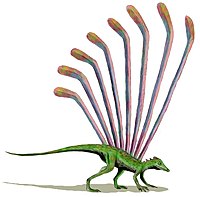 |
| Cow Branch Formation | 230 Ma | Virginia, US | This site preserves a wide variety of organisms (including Fish, reptiles, arachnids, and insects). |  |
Jurassic
| Site(s) | Age | Location | Significance | Notable fossils/organisms |
|---|---|---|---|---|
| Osteno (Moltrasio Formation)[59] | 196-188 Ma | Italy | Several kinds of marine biota such as fish, crustaceans, cephalopods polychaetes, and nematodes have been recovered. This site is the only fossil deposit in Italy in which soft bodies are preserved other than Monte Bolca .
|
chimaeriform |
| Ya Ha Tinda | 183 Ma | Alberta, Canada | A fossil site notable for containing abundant and extremely well-preserved vampire squid, being the largest concentration of vampire squid fossils outside the Tethys Ocean,[60] and for being deposited during the Toarcian Oceanic Anoxic Event (TOAE).[61][62][63] | |
| Strawberry Bank | 183 Ma | Somerset, England | A site from the TOAE documenting marine life during the recovery from the | |
| Holzmaden/Posidonia Shale | 183 Ma | Württemberg, Germany | The Sachrang member is among the most important formations of the Toarcian boundary, due to the concentrations of exceptionally well-preserved complete skeletons of fossil marine fish and reptiles. It was also deposited during the TOAE.[68][69] | Stenopterygius crassicostatus with preserved young |
| Monte Fallano | ? (Bajocian-Bathonian) | Campania, Italy | This Plattenkalk preserves fossils of terrestrial plants, crustaceans and fish.[70] | |
| Mesa Chelonia[71] | 164.6 Ma | Shanshan County, China | This site is notable because it contains a large turtle bonebed, containing specimens of the genus Annemys. This bonebed contains up to an estimated 36 turtles per square meter. | |
| La Voulte-sur-Rhône | 160 Mya | Ardèche, France | La Voulte-sur-Rhône, in the Vampyronassa rhodanica .
|
 |
| Karabastau Formation | 155.7 Ma | Kazakhstan | This site is an important locality for insect fossils that has been studied since the early 20th century, alongside the rarer remains of vertebrates, including pterosaurs, salamanders, lizards and crocodiles. |  |
| Tiaojishan Formation | 165-153 Ma | Liaoning Province , China
|
It is known for its exceptionally preserved fossils, including those
of plants, insects and vertebrates. It is made up mainly of pyroclastic rock interspersed with basic volcanic and sedimentary rocks. |
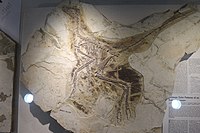 |
| Talbragar fossil site[72] | 151 Ma | New South Wales, Australia | This bed is part of Purlawaugh Formation, and provided fauna like fish and insects that lived around the lake. |  |
| Cleveland-Lloyd Dinosaur Quarry | 150 Ma | Utah, US | Jurassic National Monument, at the site of the Cleveland-Lloyd Dinosaur Quarry, well known for containing the densest concentration of Jurassic dinosaur fossils ever found, is a paleontological site located near Cleveland, Utah, in the San Rafael Swell, a part of the geological layers known as the Morrison Formation. Up to 15,000 have been excavated from this site alone. |  |
| Solnhofen Limestone | 145 Ma | Bavaria, Germany | This site is unique as it preserves a rare assemblage of theropod dinosaur Archaeopteryx preserved in such detail that they are among the most famous and most beautiful fossils in the world.
|
Archaeopteryx lithographica |
| Canjuers Lagerstätte | 145 Ma | France | This site shows a high amount of biodiversity, including reptiles, invertebrates, fish, and other organisms. | rhynchocephalian |
| Agardhfjellet Formation | 150-140 Ma | Spitsbergen, Norway | The formation contains the Slottsmøya Member, a highly fossiliferous unit where many ichthyosaur and plesiosaur fossils have been found, as well as abundant and well preserved fossils of invertebrates.
|
 |
Cretaceous
| Site(s) | Age | Location | Significance | Notable fossils/organisms |
|---|---|---|---|---|
| Angeac-Charente | ~141 Ma | Charente, France | A lagerstätte preserving both vertebrate and invertebrate fossils from the poorly represented Berriasian stage known for its taphonomic and sedimentological ‘frozen scenes’.[73] | |
| El Montsec (La Pedrera de Rúbies Formation) | ~140-125 Ma | Catalonia, Spain | Known from exceptional preservation of fossils like insect and other arthropod fossils, as well as some vertebrates. | atoposaurid crocodylomorph |
Las Hoyas |
about 125 Ma (Barremian) | Cuenca, Spain | The site is mostly known for its exquisitely preserved dinosaurs, especially enantiornithines. The lithology of the formation mostly consists of lacustarine limestone deposited in a freshwater wetland environment. |  |
| Yixian Formation | about 125–121 Ma | Liaoning, China | The Yixian Formation is well known for its great diversity of well-preserved specimens and its feathered dinosaurs, such as the large tyrannosauroid Mei, the dromaeosaurid Tianyuraptor, and the compsognathid Sinosauropteryx .
|
 |
| Jiufotang Formation | about 122-119 Ma (Aptian) | Liaoning, China | This formation overlies the slightly older Yixian Formation and preserved very similar species, including a wide variety of dinosaurs such as the ceratopsian Psittacosaurus and the early bird Confuciusornis, both of which are also found in the Yixian Formation. Also notable are the very abundant specimens of the dromaeosaurid Microraptor, which is known from up to 300 specimens and is among the most common animals found here. |  |
| Shengjinkou Formation | about 120 Ma | Xinjiang, China | Part of the finds from this site consisted of dense concentrations of pterosaur bones, associated with soft tissues and eggs. The site represented a nesting colony that storm floods had covered with mud. Dozens of individuals could be secured from a total that in 2014 was estimated to run into the many hundreds. |  |
| Xiagou Formation | about 120–115? Ma | Gansu, China | This site is known outside the specialized world of Chinese Gansus yumenensis , the earliest true modern bird.
|
 |
| Paja Formation | 130-113 Ma | Colombia | This site is famous for its vertebrate fossils and is the richest Mesozoic pliosaurs, ichthyosauras and turtles have been described from the formation and it hosts the only dinosaur fossils described in the country to date; the titanosauriform sauropod Padillasaurus .
|
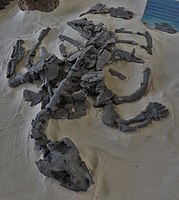 |
| Koonwarra Fossil Bed[74] | around 118-115 Ma | Victoria, Australia | This site is composed of mudstone sediment thought to have been laid down in a freshwater lake. Arthropods, fish and plant fossils are known from this site. |  |
| Crato Formation | 113 Ma | northeast Brazil | The Crato Formation earns the designation of lagerstätte due to an exceedingly well preserved and diverse fossil faunal assemblage. Some 25 species of fossil fishes are often found with stomach contents preserved, enabling paleontologists to study predator-prey relationships in this ecosystem. There are also fine examples of pterosaurs, reptiles and amphibians, invertebrates (particularly insects), and plants. Also known from this site is Ubirajara, the first non-avian dinosaur from the southern hemisphere with evidence of feathers. |  |
| Jinju Formation | 112.4–106.5 Ma | South Korea | The Jinju Formation is notable for the post-Jehol Group insect assemblage and trackways of various tetrapods, from dinosaurs and birds to lizards and hopping mammals.[75] |  |
| Tlayúa Formation | 110 Ma | Puebla, Mexico | A marine lagerstätte preserving Albian actinopterygians and lepidosaurs.[76] |  |
| Romualdo Formation | 108–92 Ma | Brazil | The Romualdo Formation is a part of the Santana Group and has provided a rich assemblage of fossils; flora, fish, arthropods insects, turtles, snakes, dinosaurs, such as Irritator, and pterosaurs, including the genus Thalassodromeus. The stratigraphic units of the group contained several feathers of birds, among those the first record of Mesozoic birds in Brazil. |  |
| Muhi Quarry (El Doctor Formation) | ? (Albian to Cenomanian, probably Late Albian)[77] | Hidalgo, Mexico | While this site produced limestones for construction, rocks in that locality contain a diverse Cretaceous marine biota such as fish, ammonites and crustaceans. | Pachyrhizodontidae |
| Puy-Puy Lagerstätte | 100.5 Ma | France | A paralic site preserving a variety of ichnofossils,[78] along with some vertebrate remains.[79] The site preserves evidence of plant-insect interaction.[80] | |
Burmese Amber |
99 Ma | Myanmar | More than 1,000 species of taxa have been described from ambers from Hukawng Valley. While it is important for understanding the evolution of biota, mainly insects, during the Cretaceous period, it is also extremely controversial by facing ethical issues due to its association with conflicts and labor conditions. |  |
| Haqel/Hjoula/al-Nammoura | about 95 Ma | Lebanon | Notable among these is the Lebanese lagerstätten of the Late Cretaceous age, which contain a well-preserved variety of different fossils. Small animals like shrimp, octopus, stingrays, and bony fishes are common finds at these sites. Some of the rarest fossils from this locality include those of octopuses. | actinopterygian |
| Vallecillo (Agua Nueva Formation) | 94–92 Ma | Nuevo León, Mexico | The site is noted for its qualities as a konservat-lagerstätte, with notable finds including the plesiosaur Mauriciosaurus and the possible shark Aquilolamna. | plesiosaur |
| Akrabou Formation (Gara Sbaa and Agoult)[81] | ? (Turonian) | Asfla, Morocco | Marine site known for exceptionally preserved, three-dimensional fish fossils. | |
| Smoky Hill Chalk | 87–82 Ma | Kansas and Nebraska, US | A Cretaceous conservation Lagerstätte known primarily for its exceptionally well-preserved marine reptiles. Also known from this site are fossils of large bony fish such as Xiphactinus, mosasaurs, flying reptiles or pterosaurs (namely Pteranodon), flightless marine birds such as Hesperornis, and turtles. |  |
| Ingersoll Shale | 85 Ma | Alabama, US | A Late Cretaceous (Santonian) informal geological unit in eastern Alabama. Fourteen theropod feathers assigned to birds and possibly dromaeosaurids have been recovered from the unit. | |
| Auca Mahuevo | 80 Ma | Patagonia, Argentina | A Cretaceous lagerstätte in the eroded titanosaurid nesting site.
|
 |
| Nardò (Calcari di Melissano)[82] | ? (upper Campanian-lower Maastrichtian) | Apulia, Italy | This site is especially famous for its limestones containing abundant fossil fish remains. | lampriform |
| Coon Creek Formation | upper Campanian - lower Maastrichtian | Tennessee and Mississippi, US | This formation has some of the world's best-preserved remains of Cretaceous marine invertebrates (primarily mollusks and decapod crustaceans), with many retaining their original aragonitic shells.[83] |  |
| Harrana (Muwaqqar Chalk Marl Formation) | ? (Late Maastrichtian) | Jordan | Phosphatic deposits formed in this site are known to preserve vertebrate fossils with soft tissue, such as mosasaurs, plesiosaurs, sharks, bony fish, turtles and crocodylians.[84] |  |
| Zhucheng (Wangshi Group) | 66 Ma | Shandong, China | Zhucheng has been an important site for theropod Zhuchengtyrannus (2011) which have all been described from deposits near and named after Zhucheng.
|
 |
| Tanis[85] | 66 Ma | North Dakota, US | Tanis is part of the heavily studied Chicxulub asteroid in extreme detail. This impact, which struck the Gulf of Mexico 66.043 million years ago, wiped out all non-avian dinosaurs and many other species (the so-called "K-Pg" or "K-T" extinction ).
|
 |
Palaeogene
| Site(s) | Age | Location | Significance | Notable fossils/organisms |
|---|---|---|---|---|
|
Menat |
60 Ma |
Auvergne, France |
A Palaeocene maar lake containing three-dimensional plant remains.[86] | |
|
55–53 Ma |
Preserves abundant Paleocene-Eocene Thermal Maximum was moderately warm (approximately 4-8 degrees warmer than today).
|
Tasbacka danica , immature sea turtle | ||
|
54–48 Ma |
England, UK |
Collected for close to 300 years, Plant fossils, especially seeds and fruits, are found in abundance. early Eocene .
|
Tynskya eocaena fossil | |
|
52 - 48 Ma |
Washington , USA
|
Includes Princeton chert & Klondike Mountain Formation; Recognized as temperate/subtropical uplands right after the Paleocene–Eocene Thermal Maximum and spanning the Early Eocene Climatic Optimum, preserves highly detailed uplands lacustrine fauna and flora.
|
Florissantia quilchenensis flower, an extinct malvaceous genus from western North America | |
| Monte Solane | 51 - 49 MA | Verona, Italy | Slightly older than the nearby, more well-known Monte Bolca site, the Monte Solane site also preserves numerous marine fish and plants, but documents an entirely different ecosystem that appears to be of a bathypelagic habitat, forming one of the few known lagerstätte to preserve a deep-sea ecosystem.[87] | |
|
50 Ma |
Colorado/Utah/Wyoming, US |
An Eocene aged site that is noted for the fish fauna preserved. Other fossils include the birds, and mammals .
|
 | |
|
49 Ma |
Verona, Italy |
A fossil site with specimens of fish and other organisms that are so highly preserved that their organs are often completely intact in fossil form, and even the skin color can sometimes be determined. It is assumed that mud at the site was low in oxygen, preventing both decay and the mixing action of scavengers from harming the fossils. |
 | |
|
Messel Formation
|
49 Ma |
Hessen, Germany |
This site has significant geological and scientific importance. Over 1000 species of plants and animals have been found at the site. After almost becoming a landfill, strong local resistance eventually stopped these plans and the Messel Pit was declared a UNESCO World Heritage Site on 9 December 1995. Significant scientific discoveries about the early evolution of mammals and birds are still being made at the Messel Pit, and the site has increasingly become a tourist site as well.
|
 |
| Kishenehn Formation | 46.2 Ma | Montana | A Middle Eocene site preserving exquisitely detailed insect specimens in oil shale.[88] | |
| Mahenge | 46 Ma | Tanzania | A terrestrial Middle Eocene lagerstätte preserving plant and arthropod fossils.[89][90] | |
|
45-25 Ma |
Occitania, France |
This site qualifies as a lagerstätte because beside a large variety of mammals, birds, turtles, crocodiles, flora and insects, it also preserves the soft tissues of amphibians and natural mummies .
|
 | |
|
34 Ma |
Colorado |
A late Eocene (Priabonian) aged site that is noted for the finly preserved plant and insect paleobiota. Fossils are preserved in diatom blooms of a lahar dammed lake system and the formation is noted for the petrified stumps of Sequoia affinis |
Palaeovespa florissantia | |
| Rauenberg | 30 Ma | Baden-Württemberg, Germany | A marine fossil site with an Arctic-like invertebrate fauna and a Paratethyan vertebrate fauna displaying evidence of intermittent anoxia.[92] | |
| Sangtang Lagerstätte | ~28 – 23 Ma | Guangxi, China | A section of the Late Oligocene Yongning Formation with one of the very few known Cenozoic assemblages of mummified plant fossils.[93] | |
|
Enspel Lagerstätte |
24.79-24.56 Ma |
Rhineland-Palatinate, Germany |
||
| Aix-en-Provence | ~24 Ma | Provence, France | A terminal Oligocene brackish palaeoenvironment.[95] |
Neogene
| Site(s) | Age | Location | Significance | Notable fossils/organisms |
|---|---|---|---|---|
| Dominican amber | 30–10 Ma | Dominican Republic | Dominican amber differentiates itself from Baltic amber by being nearly always[citation needed] transparent, and it has a higher number of fossil inclusions. This has enabled the detailed reconstruction of the ecosystem of a long-vanished tropical forest.[96] |  |
Riversleigh |
25–15 Ma | Queensland, Australia | This locality is recognised for the series of well preserved fossils deposited from the Late Oligocene to the Miocene. The fossiliferous limestone system is located near the Gregory River in the north-west of Queensland , an environment that was once a very wet rainforest that became more arid as the Gondwanan land masses separated and the Australian continent moved north.
|
 |
| Foulden Maar | 23 Ma | Otago, New Zealand | These layers of |  |
Chiapas amber |
23-15 Ma | Chiapas, Mexico[99] | As with other ambers, a wide variety of taxa have been found as inclusions including insects and other arthropods, as well as plant fragments and epiphyllous fungi. | Anbarrhacus adamantis . |
| Clarkia fossil beds | 20-17 Ma | Idaho, US | The Clarkia fossil beds site is best known for its fossil leaves. Their preservation is exquisite; fresh leaves are unfossilized, and sometimes retain their fall colors before rapidly oxidizing in air. It has been reported that scientists have managed to isolate small amounts of ancient DNA from fossil leaves from this site. However, other scientists are skeptical of the validity of this reported occurrence of Miocene DNA.
|
 |
| Barstow Formation | 19–13.4 Ma | California, US | The sediments are footprints. The formation is also renowned for the fossiliferous concretions in its upper member, which contain three-dimensionally preserved arthropods.
|
 |
| Shanwang Formation | 18-17 Ma | Shandong Province, China | Fossils have been found at this site in dozens of categories, representing over 600 separate species. Animal fossils include insects, fish, spiders, amphibians, reptiles, birds and mammals. Insect fossils have clear, intact veins. Some have retained beautiful colours. |  |
| Morozaki Group[100] | 18-17 Ma | Aichi Prefecture, Japan | Known from well-preserved deep sea fauna including fish, starfish and arthropods like crabs, shrimps and giant amphiopods. | |
| Sandelzhausen | 16 Ma | Bavaria, Germany | A Middle Miocene vertebrate locality.[101] | |
| McGraths Flat | ~16-11 Ma | NSW , Australia
|
Deposited in unusual conditions that record microscopic details of soft tissues and delicate structures. Fossil evidence of animals with soft bodies, unlike the bones of mammals and reptiles, is rare in Australia, and discoveries at McGraths' Flat have revealed unknown species of invertebrates such as insects and spiders.[102] | |
| Pisco Formation | 15-2 Ma | Arequipa & Ica, Peru | Several specialists consider the Pisco Formation one of the most important lagerstätten, based on the large amount of exceptionally preserved marine fossils, including sharks (most notably giant sloths .
|
 |
| Hindon Maar | 14.6 Ma | New Zealand | A maar preserving a Southern Hemisphere lake-forest ecosystem, including body fossils of plants, insects, fish, and birds,[103] along with in situ pollen[98] and coprolites of both fish and birds.[103] | |
| Ngorora Formation | 13.3-9 Ma | Tanzania | The alkaline palaeolake deposits of the Ngorora Formation contains articulated fish fossils that died en masse from asphyxiation during episodic ash falls or from rapid acidification.[104] |  |
| Pi Gros | 13 Ma | Catalonia, Spain | An ichnofossil lagerstätte containing annelid, mollusc, and sponge trace fossils. The fossil site no longer exists due to having been quarried for the construction of an industrial park.[105] | |
| Bullock Creek | 12 Ma | Northern Territory, Australia | Among the fossils at the Bullock Creek site have been found complete marsupial crania with delicate structures intact. New significant taxa identified from the Bullock Creek mid Miocene include a new genus of crocodile, dasyurid material has also been recovered.
|
|
| Tunjice | ? (Middle Miocene) | Slovenia | This site is known worldwide for the earliest fossil records of seahorses.[106] |  |
| Ashfall Fossil Beds | 11.83 Ma | Nebraska, US | The Ashfall Fossil Beds of Antelope County in northeastern Nebraska are rare fossil sites of the type called lagerstätten that, due to extraordinary local conditions, capture an ecological "snapshot" in time of a range of well-preserved fossilized organisms. Ash from a Yellowstone hotspot eruption 10-12 million years ago created these fossilized bone beds. |  |
Alcoota Fossil Beds |
8 Ma | Northern Territory, Australia | It is notable for the occurrence of well-preserved, rare, Miocene vertebrate fossils, which provide evidence of the evolution of the Northern Territory's fauna and climate. The Alcoota Fossil Beds are also significant as a research and teaching site for palaeontology students. |  |
| Saint-Bauzile | 7.6-7.2 Ma | Ardèche, France | A Late Miocene site preserving articulated mammal skeletons with skin and fur impressions.[107] | |
| Tresjuncos | 6 Ma | Cuenca, Spain | A Late Miocene lacustrine konservat-lagerstätte containing fossils of diatoms, plants, crustaceans, insects, and amphibians.[108] | |
| Gray Fossil Site | 4.9-4.5 Ma | Tennessee, US | As the first site of its age known from the Appalachian region, the Gray Fossil Site is a unique window into the past. Research at the site has yielded many surprising discoveries, including new species of red panda, rhinoceros, pond turtle, hickory tree, and more. The site also hosts the world's largest known assemblage of fossil tapirs. |  |
Quaternary
| Site(s) | Age | Location | Significance | Notable fossils/organisms |
|---|---|---|---|---|
| The Mammoth Site | 26 Ka |
South Dakota, US | The facility encloses a prehistoric sinkhole that formed and was slowly filled with sediments during the Pleistocene era. As of 2016, the remains of 61 mammoths, including 58 North American Columbian and 3 woolly mammoths had been recovered. Mammoth bones were found at the site in 1974, and a museum and building enclosing the site were established. | Arctodus simus , a large species of "short-faced" bear that was one of North America's largest predators during the Pleistocene. |
| Rancho La Brea Tar Pits | 40–12 Ka | California, US | A group of Smilodon fatalis ).
|
Mammuthus columbi excavated from the tar pits |
| Waco Mammoth National Monument | 65–51 Ka |
Texas, US | A paleontological site and Epoch have been uncovered. The site is the largest known concentration of mammoths dying from a (possibly) reoccurring event, which is believed to have been a flash flood .
|
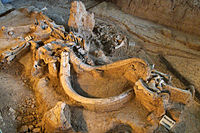 |
| El Breal de Orocual | 2.5–1 Ma | Monagas, Venezuela | The largest asphalt well on the planet. Like the La Brea Tar Pits, this site preserves a number of megafauna like Homotherium venezuelensis .
|
Myrmecophaga |
| El Mene de Inciarte | 28–25.5 Ka | Zulia, Venezuela | Another series of tar pits. These also preserve a similar assemblage of megafauna. | |
Naracoorte Caves |
500-1 Ka |
South Australia, Australia | A series of caves that preserve numerous pleistocene megafauna, like Thylacoleo, and is recognized as a World heritage site alongside the older, but geographically similar Riversleigh site. |  |
| Mare aux Songes | 4 Ka | Mauritius | A marsh that preserves a diversity of subfossil animals and plants, many of which were driven to extinction without proper documentation following human arrival, most notably the famous dodo. The mortality assemblages may have formed from a freshwater lake that was occasionally impacted by catastrophic droughts.[109] |  |
See also
- List of fossil sites (with link directory)
- Hoard, a concentration of human artifacts useful for similar reasons in archaeology
References
- ^ The term was originally coined by Adolf Seilacher in: Seilacher, A. (1970). "Begriff und Bedeutung der Fossil-Lagerstätten: Neues Jahrbuch fur Geologie und Paläontologie". Monatshefte (in German). 1970: 34–39.
- ^ Briggs et al. 1983; Aldridge et al. 1993.[full citation needed]
- .
- S2CID 229003508. Retrieved 18 June 2023.
- S2CID 254411264. Retrieved 30 April 2023.
- . Retrieved 30 April 2023.
- PMID 35418588.
- S2CID 140668863. Retrieved 30 April 2023.
- PMID 33159138.
- S2CID 225242787. Retrieved 30 April 2023.
- . Retrieved 18 June 2023.
- S2CID 221477265. Retrieved 30 April 2023.
- ISSN 0031-0182.
- . Retrieved 12 November 2022.
- ^ Gámez Vintaned, J. A.; Liñán, E. y Gozalo, R. (2013) «Los trilobites cámbricos de la Biota de Murero (Zaragoza, España)». Cuadernos de Paleontología Aragonesa, 7: 5-27
- PMID 35832778. Retrieved 2 April 2023.
- PMID 35858062.
- ^ ISSN 0315-0941.
- S2CID 132698401. Retrieved 18 March 2023.
- S2CID 135129430. Retrieved 10 April 2023.
- S2CID 253297071.
- S2CID 181399467. Retrieved 27 April 2023.
- S2CID 252569910.
- ^ BBC. "Fossils found in 425 million year old 'Pompeii'". www.bbc.co.uk. Retrieved 7 October 2023.
- S2CID 30066085.
- ISBN 9780521450249, retrieved 9 October 2023
- S2CID 231793893. Retrieved 29 April 2023.
- S2CID 198137119. Retrieved 29 April 2023.
- . Retrieved 29 June 2023.
- S2CID 210627752.
- S2CID 129070535.
- PMID 27552196.
- ISBN 978-1-78046-014-7.
- .
- ^ "Direct Evidence of Food Chains at the Linton Lagerstatte". gsa.confex.com.
- ^ Dunne, Emma M. (1 July 2020). Patterns and drivers of tetrapod diversity and biogeography in the late Palaeozoic and early Mesozoic (d_ph thesis). University of Birmingham.
- ISSN 0272-4634.
- New Mexico Museum of Natural History and Science Bulletin. 84: 359–390.
- .
- JSTOR 24989233.
- . Retrieved 18 December 2023.
- . Retrieved 29 April 2023.
- . Retrieved 8 June 2022.
- .
- ISSN 0960-9822.
- .
- PMID 36310243.
- PMID 2574883.
- S2CID 132822933. Retrieved 18 June 2023.
- S2CID 256697946.
- PMID 28246643.
- ^ PMID 30963850.
- S2CID 219097612. Retrieved 28 April 2023.
- PMID 21183583.
- . Retrieved 18 June 2023.
- PMID 33239675.
- PMID 35442996.
- PMID 34404880.
- S2CID 258822179.
- S2CID 135120464. Retrieved 8 April 2023.
- . Retrieved 29 April 2023.
- S2CID 56182151. Retrieved 29 April 2023.
- S2CID 208268686. Retrieved 29 April 2023.
- S2CID 52971056. Retrieved 18 June 2023.
- S2CID 256258263. Retrieved 18 June 2023.
- S2CID 203358919. Retrieved 18 June 2023.
- PMID 36175086.
- S2CID 258545235. Retrieved 10 July 2023.
- . Retrieved 1 July 2023.
- .
- S2CID 17423081
- PMID 28582427.
- S2CID 234299378. Retrieved 29 June 2023.
- S2CID 133845914.
- PMID 31527673.
- . Retrieved 29 June 2023.
- ISSN 0895-9811.
- S2CID 133649140. Retrieved 18 June 2023.
- . Retrieved 18 June 2023.
- S2CID 250241945. Retrieved 18 June 2023.
- PMC 7442934.
- PMC 6030324.
- ISSN 1472-4677.
- ISSN 2041-1723.
- PMID 30936306.
- . Retrieved 29 April 2023.
- ISSN 0031-0182.
- S2CID 53364401. Retrieved 3 May 2023.
- PMID 10991905. Retrieved 29 June 2023.
- S2CID 91844938. Retrieved 29 June 2023.
- PMID 24086389.
- . Retrieved 29 April 2023.
- ISSN 1674-7313.
- S2CID 84729592. Retrieved 29 April 2023.
- S2CID 134885555. Retrieved 29 June 2023.
- ISBN 0-691-02888-5
- S2CID 132004293. Retrieved 29 April 2023.
- ^ S2CID 255325092. Retrieved 29 April 2023.
- PMID 25162220.
- PMID 22563389.
- S2CID 55172519. Retrieved 29 April 2023.
- PMID 34995110.
- ^ S2CID 134962038. Retrieved 29 April 2023.
- S2CID 130521301. Retrieved 29 June 2023.
- S2CID 135386238. Retrieved 1 May 2023.
- ISSN 0753-3969.
- S2CID 134016889. Retrieved 1 May 2023.
- S2CID 133950518. Retrieved 29 April 2023.
- ISSN 0277-3791.
Further reading
- Penney, D. (ed.) 2010. Biodiversity of Fossils in Amber from the Major World Deposits. Siri Scienfic Press, Manchester, 304 pp.
- "Fossil Lagerstätten". Department of Earth Sciences, University of Bristol. 2003. Archived from the original on 12 June 2007. Retrieved 21 November 2005. – A catalogue of sites of exceptional fossil preservation produced by MSc palaeobiology students at University of Bristol's Department of Earth Sciences.
- Orr, Patrick J.; S2CID 129635160. Retrieved 26 October 2006.
